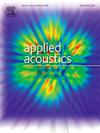Incorporating extended neck Helmholtz resonators into an advanced multi-degree of freedom acoustic metamaterial for low-frequency, broadband acoustic absorption
IF 3.4
2区 物理与天体物理
Q1 ACOUSTICS
引用次数: 0
Abstract
This study investigates the novel design and evaluation of a low-frequency, broadband, noise-absorbing acoustic metamaterial. The technology combines the sound-absorbing characteristics of micro-perforated panels with extended neck Helmholtz resonators. Individual sub-chambers can have unique properties such as depth, porosity, hole diameter, extended neck length, and neck internal diameter. An optimisation algorithm is implemented to ensure that broadband absorption is maximised in a low-frequency range of interest. The Helmholtz resonators couple with the response of the micro-perforated panels so that the combined response is both more broadband and of lower frequency than could be attained by the elements individually. Low frequencies below 500 Hz are of interest in the study, and the area exposed to the sound field is limited to 0.04 m2, so the technology is considered to be a locally reacting absorber. Experimental results indicate that perfect sound absorption of over 99.9% at 329.6 Hz with a 51 mm thickness (sub-wavelength ratio = 1/20.4) can be achieved with one configuration, which emphasises maximum absorption. A second configuration, which emphasises broadband absorption, achieves an average sound absorption coefficient of 0.8 in the 254 Hz to 500 Hz range. Experimental results compare well with analytical and numerical results and outperform some results found in the literature.
将扩展颈亥姆霍兹谐振器集成到先进的多自由度声学超材料中,用于低频宽带声吸收
本研究探讨一种低频、宽频带、吸音的声学超材料的新设计与评估。该技术将微穿孔板的吸声特性与长颈亥姆霍兹谐振器相结合。单个子腔室可以具有独特的属性,如深度、孔隙度、孔径、延伸颈长和颈内径。实现了优化算法,以确保在感兴趣的低频范围内宽带吸收最大化。亥姆霍兹谐振腔与微穿孔板的响应耦合,使得组合响应比单个元件获得的响应更宽,频率更低。500hz以下的低频是研究的重点,暴露于声场的面积被限制在0.04 m2,因此该技术被认为是局部反应吸收器。实验结果表明,在厚度为51 mm(亚波长比为1/20.4)的329.6 Hz下,一种强调最大吸声的配置可以实现99.9%以上的完美吸声。第二种配置强调宽带吸收,在254 Hz到500 Hz范围内平均吸声系数为0.8。实验结果与解析和数值结果比较好,优于文献中的一些结果。
本文章由计算机程序翻译,如有差异,请以英文原文为准。
求助全文
约1分钟内获得全文
求助全文
来源期刊

Applied Acoustics
物理-声学
CiteScore
7.40
自引率
11.80%
发文量
618
审稿时长
7.5 months
期刊介绍:
Since its launch in 1968, Applied Acoustics has been publishing high quality research papers providing state-of-the-art coverage of research findings for engineers and scientists involved in applications of acoustics in the widest sense.
Applied Acoustics looks not only at recent developments in the understanding of acoustics but also at ways of exploiting that understanding. The Journal aims to encourage the exchange of practical experience through publication and in so doing creates a fund of technological information that can be used for solving related problems. The presentation of information in graphical or tabular form is especially encouraged. If a report of a mathematical development is a necessary part of a paper it is important to ensure that it is there only as an integral part of a practical solution to a problem and is supported by data. Applied Acoustics encourages the exchange of practical experience in the following ways: • Complete Papers • Short Technical Notes • Review Articles; and thereby provides a wealth of technological information that can be used to solve related problems.
Manuscripts that address all fields of applications of acoustics ranging from medicine and NDT to the environment and buildings are welcome.
 求助内容:
求助内容: 应助结果提醒方式:
应助结果提醒方式:


